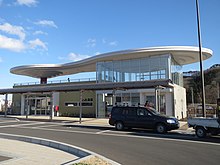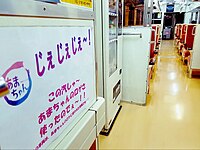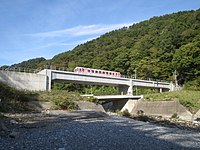Sanriku Railway
Sanriku Tetsudō ( 三 陸 鉄 道 ) is a Japanese railway company founded in 1981, which is received as a so-called “ third sector ” railway, with government grants. The term Santetsu ( 三 鉄 ) is colloquial .
The name Sanriku is derived from the old name of the coastal region of the modern Iwate Prefecture . Large parts of the region are part of the Sanriku Fukkō National Park .
Route network
As early as 1941, a six-kilometer stretch near Hikoroichi had been built, the time circumstances prevented further construction. In 1952 another four kilometers were added to Akasaki. The last sections of the Miyako and Kuji lines had only opened in the 1970s.
The state railway JNR had wanted to give up the routes as unprofitable in the early 1980s.
The Rias line ( リ ア ス 線 ) operated by the company is a continuous single track and 163 km long between Kuji ( 久 慈 市 ) in the north and Ōfunato-Sakari in the south. However, for administrative reasons, it is divided into three sections (north-south):
- Kuji to Miyako ( 宮 古 駅 ), scheduled 1h40
- Miyako to Kamaishi (pronounced Kama-ishi, 釜 石 駅 ), scheduled 1h20
- Kamaishi to Sakari ( 盛 駅 )
The few journeys that cover the entire route take around 4½ hours. In total it goes through 42 tunnels. The operation is not clocked, during the day a train runs about every 90 minutes. It is stopped at all train stations. Only in the Miyako-Kuji section are there a few express trains that do not serve a few stops. The southern branch Miyako to Kamaishi, formerly part of the JR Yamada Line, was transferred to the Santetsu after the repairs were completed in 2019.
The central depot is in Miyako station. The company's own shop Santetsuya sells souvenirs for rail enthusiasts. The then new Kamaishi stop opened in 1985. Thereafter, there was no reopening until the establishment of Yamaguchi-Danchi in 2010. When the Yamada route was taken over in 2019, the Haraigawa ( 払 川 駅 ) and Yagisawa / Miyako Junior College ( 八 木 沢 ・ 宮 古 短 大 駅 ) stops were set up . In 2020 there were 40 stations in operation.
connections
Connections with the JR East network are:
- in Koji to the Hachinohe Line to the north
- from Miyako inland towards Morioka on the Yamada line
- from Kamaishi inland towards Hanamaki
- in Sakari with the Ōfunato line to the south
Natural disasters
Due to the route near the coast, the route goes over numerous bridges and tunnels that are prone to natural disasters. This was despite the fact that predictable damage in the order of magnitude of the effects of the Meiji-Sanriku earthquake in 1896 had been taken into account when planning the route .
The company's routes were so badly affected by the Tōhoku earthquake in 2011 that they could not be used at all until April 2014. A good 5.8 km of rails had been completely washed away. 107 km of tracks had to be repaired. The Kuwaiti government donated three trains. The Miyako to Kamaishi section, formerly the Yamada line, was only put back into operation on March 23, 2019. In the meantime, the two branches available were named: Kita Rias and Minami Rias stretch. The further effects of the Fukushima nuclear disaster on today's users are generally not discussed in Japan.
The typhoon Hagibis damaged seventy percent of the route in October 2019 at a total of 93 points. Until the damage was completely repaired in March 2020, shuttle operations were carried out on sections of the route.
vehicles
All trains are used in one-man operation.
After the earthquake, five new diesel railcars were purchased. For normal operation three vehicles from the 36-700 series, plus a 36-Z, which can also be booked for tour groups on the northern section of the route. There is a small exhibition of regional handicrafts in this vehicle. In addition, a vehicle in the classic car look 36-R3. The series 36-600 is imitated.
Since 2017, tourist trips have been offered in the northern section of the route in winter from December to February with the Kotatsu car and in summer with the retro-look car ( お 座 敷 列車 ).
literature
Individual evidence
Web links
- Official website (English).
- News about Santetsu in Rail Fan magazine (Japanese only)






